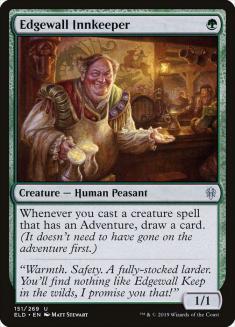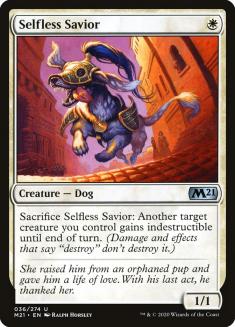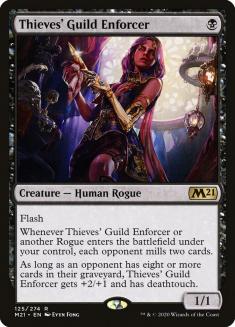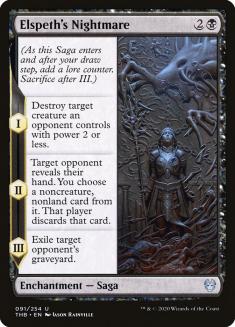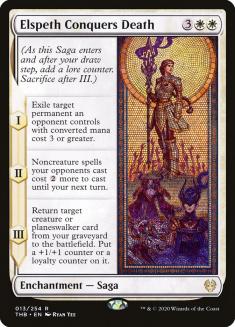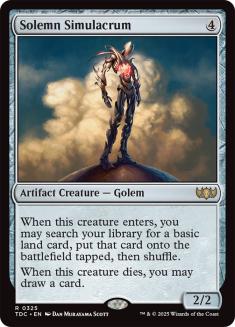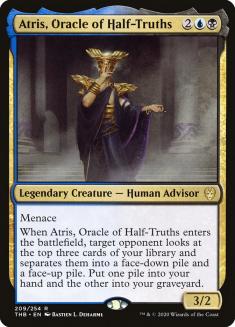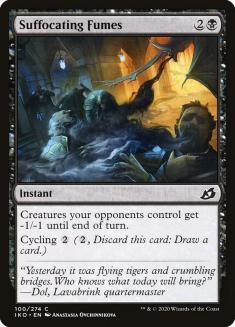In the last month, control enthusiasts have had a rough go in Kaldheim Standard. I personally have enjoyed the format, regularly tweaking Esper Control to handle the new metagame that continues to get more aggressive each week. At the beginning, I butchered my lists to handle Sultai Ramp (Yorion), adding many more counterspells to the maindeck over removal. This helped even the playing field for the control side of the battlefield, and I was able to post a successful win rate over a difficult matchup on paper. The issue with doing this is the aggressive side of the metagame is waiting in the wings, ready to punish control players for going light on the black spells.
Aggressive decks dominated this past weekend’s SCG Tour Online $5k Strixhaven Championship Qualifier. Except for two Sultai Ramp decks, the rest of the competitors were playing one-drop creatures. Whether it’s Edgewall Innkeeper, Selfless Savior, or Thieves’ Guild Enforcer, control must have a removal spell at the ready to be successful. Negate is a powerful card in most of the matchups, as the noncreature spells are tough to beat; however, victory can be forged without it. The deal-breaker is letting these creatures slip through and stretch our Doomskars too thin. For control to bounce back in Kaldheim Standard, our deck must have the requisite amount of black and blue disruption while utilizing the white haymakers that best showcase the late-game power.
Creatures (2)
Planeswalkers (6)
Lands (25)
Spells (27)

This is my most up-to-date Esper Control deck that I have been testing over the last few weeks. It’s like lists I have posted in the past, with additional counterspells to help fight off the Sultai Ramp decks that gained tremendous popularity overnight. This version of Esper Control has a decent matchup against that deck, as well as the aggressive decks that run the top tables. Even though Mono-White Aggro❄ has access to creatures that gain indestructible, the two copies of Suffocating Fumes have helped give a slight edge in Game 1.
In the sideboarded games, Extinction Event and Erebos’s Intervention help bail out Doomskar in that matchup and further enhance the deck against the more traditional aggro decks. Dimir Rogues (Lurrus), Temur Adventures, and Mono-Red Aggro❄ are all beatable —it just takes a little more work. That was the tradeoff to have game against Sultai Ramp; however, there may be a better way.
I stayed off the Yorion, Sky Nomad train for as long as I could. After the companion rule change, I shouted from the rooftops that this would not remove Yorion or Lurrus from competitive play in Standard. The deckbuilding restrictions are still too lax, making it very easy to enlist these two companions. The payoff for both is huge and control decks will likely have to follow the 80-card model until it rotates.
The traditionalist in me wanted to ensure that the 60-card version of Esper Control got its fair shake in Kaldheim Standard. It has been successful for me and many of my readers; however, it looks like the time has come to add a few more cards to the maindeck to get Yorion officially on the team. For control players, adding extra cards is an easy task. One of the most painful parts of deckbuilding is cutting that beautiful one-of that you want to draw at some point in the game or having to play less than four of a card that’s amazing if the room was there. I love building Yorion control decks, especially this one.
Creatures (7)
Planeswalkers (8)
Lands (30)
Spells (35)

Esper Control (Yorion) does not follow the path that the previous Esper Control deck paved. The 60-card version of this deck was reactive in nature, only tapping out for a few key planeswalkers and sweepers. Now that the deck has evolved to include Yorion, tap-out threats that benefit from blinking became a must. Since I’m a tap-out fanatic, there will be no argument from me for this conversion. Some of the most powerful spells printed require the mana to be used on your own turn and that’s by design. The game has moved away from the broken instant-speed interactions, making Esper Control (Yorion) play by the same rules as others to achieve that level of strength.
The number of planeswalkers and creatures/enchantments that have a trigger when entering the battlefield significantly increased. Just in the maindeck, Esper Control (Yorion) has 23 cards that benefit from Yorion resolving. Some of these cards are among the usual suspects you would see in a typical 80-card control deck in Kaldheim Standard. Spells like Elspeth’s Nightmare and Omen of the Sea replace other cards in their respective categories, to have the chance to enter the battlefield on multiple occasions.
Elspeth’s Nightmare is a card I’ve always liked, but rarely played. It’s a removal spell that mimics Eliminate but has the downside of being sorcery-speed. Even though it could take out a noncreature card from the opponent’s hand and hit the graveyard, the extra mana and main-phase mana investment was too high of a cost for me. That all changes when Yorion is a guaranteed draw in the companion slot, which also holds true for Omen of the Sea.
I put Omen of the Sea aside when Frantic Inventory was printed. I buried opponents under card advantage with Frantic Inventory and still think it’s one of the most underutilized cards in Kaldheim Standard. The issue with it is that it takes four slots and must be drawn in multiples to be effective. The four-of requirement is an easy cost to satisfy in a deck with Yorion; however, drawing multiple copies is more unlikely in the 80-card deck. There’s no dispute which is better in this version of Esper Control, as blinking an Omen of the Sea feels so good. That interaction alone makes it one of the best cards in the deck and one of the reasons to play it.
Elspeth Conquers Death is the centerpiece of Esper Control, with or without Yorion. Blinking this five-mana enchantment is a detrimental series of events for the opponent, making it even better in the 80-card version of Esper Control. There’s little reason to run other universal removal spells while this is in the decklist. Elspeth Conquers Death hits everything problematic, increases the cost of noncreature spells, and returns one of the many devastating planeswalkers or creatures to the battlefield. Without ECD in the mix, I would have committed to Dimir Control from the start, leaning only on reactive spells and Extinction Event for the next few months.
The new additions to Esper Control are primarily here to maximize Yorion. I love Solemn Simulacrum, but it’s not going to turn heads like the other spells in the deck do. Just having the sad robot in the lineup has been a nostalgic revival for me, even though its power level has dropped significantly since its last reprint. In Kaldheim Standard, it does a good job getting more land onto the battlefield for the double spell turns and an eventual Ugin, the Spirit Dragon arrival. If it does everything it’s supposed to do — get a land, block, and then draw a card — things are going very well for the control user that game. The bonus of a Yorion blink gives Solemn Simulacrum another layer of strength in the situations where his combat death is unlikely. I couldn’t bring myself to playing four copies in Esper Control (Yorion) though, especially when the superior four-drop has joined the squad.
I always look for an excuse to play Atris, Oracle of Half-Truths. In the final days of Esper Hero, it was the last hope for the deck to stay relevant. Even though Atris showcased its strength well in that deck, Hero of Precinct One was not able to return to its former glory. I learned a lot playing Atris then and I know how strong it would be with a little Yorion assistance. Unlike with Solemn Simulacrum, Atris is effective in combat, digs deeper to find a needed spell, and can draw multiple cards. When Atris is blinked, it provides a heavier dose of card advantage in comparison to its robot friend. Since it’s a legend, the split between the two is the best starting point, but that could be temporary. Ugin is still the goal of Esper Control (Yorion) and Solemn Simulacrum opens the door for its early entrance. For this reason alone, Atris is a two-of compared to the Solemn Simulacrum three-of, even though it’s a superior presence on the battlefield.
The rest of the deck mirrors that of my traditional Esper Control deck. The same counterspells, creatures, removal, and planeswalkers exist in both builds, apart from a couple more copies of Ugin. These spells have proven themselves in competitive play and I have full confidence in their strength in this Yorion version. Saw It Coming, Behold the Multiverse, and Doomskar are fantastic additions from Kaldheim that are essential inclusions for control decks that can cast them. Even though there are alternatives for each of those effects, these superior staples outperform the competition.
There was only room for one Suffocating Fumes in Esper Control (Yorion), which may seem contradictory to the space argument I presented earlier. The reason for this single copy is the existence of Elspeth’s Nightmare, as it takes two additional removal spots that could have been used for another Suffocating Fumes or Eliminate. Even though it has another mode that disrupts the hand, its primary purpose is to remove a creature from the battlefield while giving Yorion more fuel upon resolution. The matchup between Esper Control (Yorion) and aggro decks, with a focus on Mono-White Aggro❄, improves in comparison to that of traditional Esper Control. This is because of the creature package that blocks, buys time, and eventually leads to Ugin winning the game.
The tradeoff for switching from 60 to 80 cards rests on the power of Ugin. Aggro decks do not kill as quickly as they used to, making this expensive game-ender a powerful strategy moving forward. The threats in these aggro decks have moved away from devastating early-game attacks to highly efficient mid-game battlefield dominance. Their creatures provide more value and resiliency, at the cost of speed. This is good for a deck that has an eight-mana win condition, which is why Esper Control (Yorion) is in a good place to take on the format. The trick will be to maintain that medium matchup with Sultai Ramp (Yorion), while being able to muck up the battlefield enough to take down the aggro players with a well-timed Doomskar into an Ugin.
I have high hopes for this deck to do just that.


